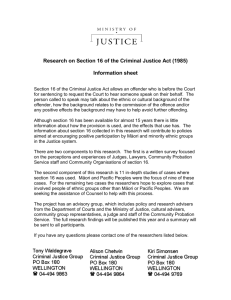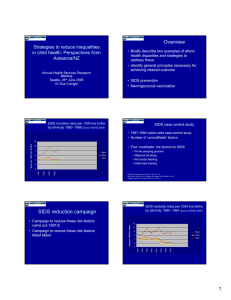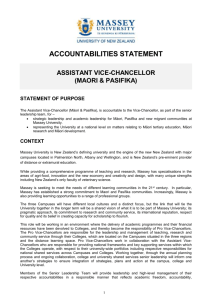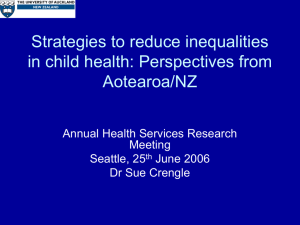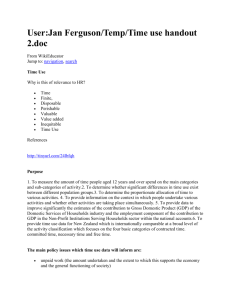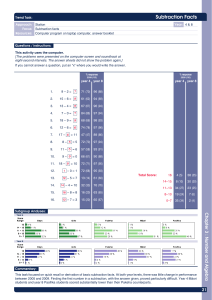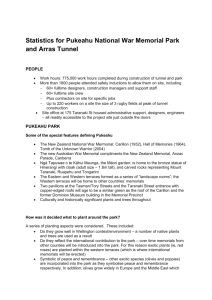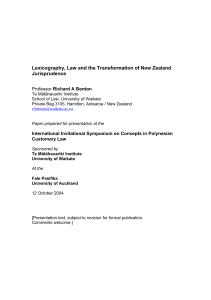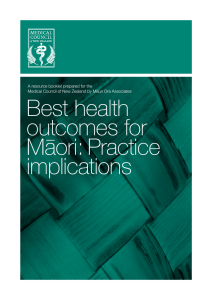TE PAE MAHUTONGA A MODEL FOR MAORI HEALTH
advertisement
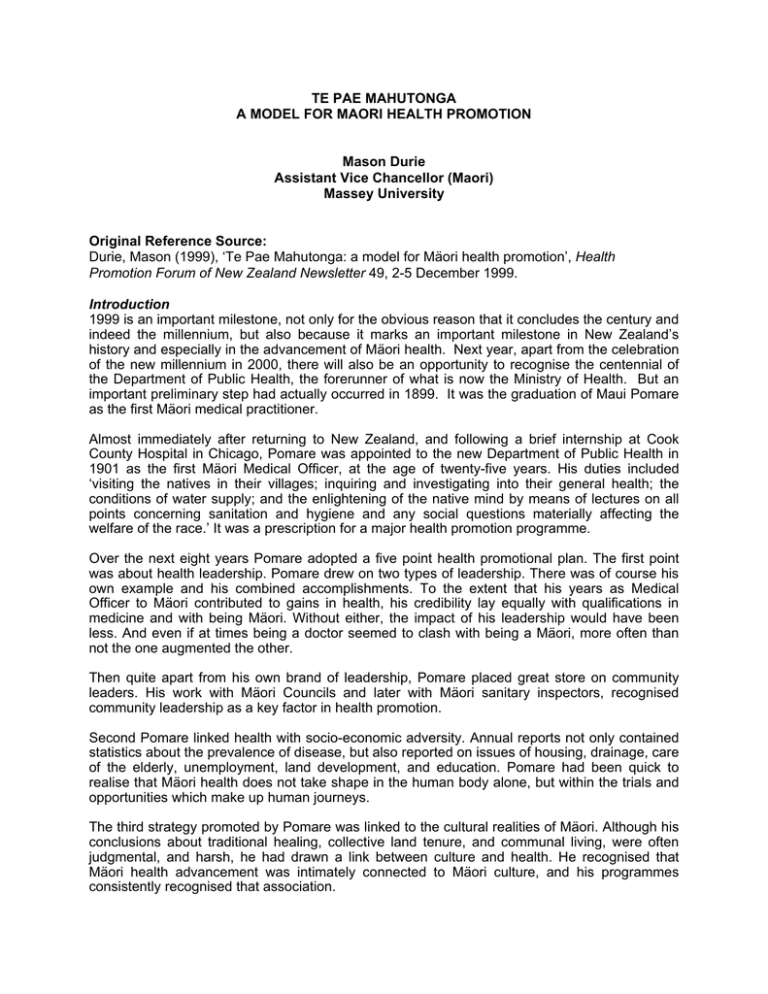
TE PAE MAHUTONGA A MODEL FOR MAORI HEALTH PROMOTION Mason Durie Assistant Vice Chancellor (Maori) Massey University Original Reference Source: Durie, Mason (1999), ‘Te Pae Mahutonga: a model for Mäori health promotion’, Health Promotion Forum of New Zealand Newsletter 49, 2-5 December 1999. Introduction 1999 is an important milestone, not only for the obvious reason that it concludes the century and indeed the millennium, but also because it marks an important milestone in New Zealand’s history and especially in the advancement of Mäori health. Next year, apart from the celebration of the new millennium in 2000, there will also be an opportunity to recognise the centennial of the Department of Public Health, the forerunner of what is now the Ministry of Health. But an important preliminary step had actually occurred in 1899. It was the graduation of Maui Pomare as the first Mäori medical practitioner. Almost immediately after returning to New Zealand, and following a brief internship at Cook County Hospital in Chicago, Pomare was appointed to the new Department of Public Health in 1901 as the first Mäori Medical Officer, at the age of twenty-five years. His duties included ‘visiting the natives in their villages; inquiring and investigating into their general health; the conditions of water supply; and the enlightening of the native mind by means of lectures on all points concerning sanitation and hygiene and any social questions materially affecting the welfare of the race.’ It was a prescription for a major health promotion programme. Over the next eight years Pomare adopted a five point health promotional plan. The first point was about health leadership. Pomare drew on two types of leadership. There was of course his own example and his combined accomplishments. To the extent that his years as Medical Officer to Mäori contributed to gains in health, his credibility lay equally with qualifications in medicine and with being Mäori. Without either, the impact of his leadership would have been less. And even if at times being a doctor seemed to clash with being a Mäori, more often than not the one augmented the other. Then quite apart from his own brand of leadership, Pomare placed great store on community leaders. His work with Mäori Councils and later with Mäori sanitary inspectors, recognised community leadership as a key factor in health promotion. Second Pomare linked health with socio-economic adversity. Annual reports not only contained statistics about the prevalence of disease, but also reported on issues of housing, drainage, care of the elderly, unemployment, land development, and education. Pomare had been quick to realise that Mäori health does not take shape in the human body alone, but within the trials and opportunities which make up human journeys. The third strategy promoted by Pomare was linked to the cultural realities of Mäori. Although his conclusions about traditional healing, collective land tenure, and communal living, were often judgmental, and harsh, he had drawn a link between culture and health. He recognised that Mäori health advancement was intimately connected to Mäori culture, and his programmes consistently recognised that association. The fourth strategy occurred after Pomare left the Department of Public Health. As a member of Parliament and as Minister of Health Pomare was able to wield a degree of influence on the health system which is only possible at Ministerial levels. Political commitment to health was, he discovered, equally if not more important than commitment at community and professional levels. The fifth strategy was to develop a sufficient team of skilled health workers; Pomare set the style with his dual cultural and medical qualifications. But he acknowledged the skills of community Leaders and encouraged them to become involved in health. His workforce strategy was to develop a strong network of community health workers, around whom community programmes could take form. Then he began to advocate for more Mäori nurses, not to work in isolation but alongside the community workers, one bringing clinical skills, the other leadership and a firsthand knowledge of Mäori aspirations and existing conditions. Much later, well after Pomare had died, the Ottawa Charter became the accepted prescription for health promotion: healthy public policy, supportive environments, community action, personal skills, reoriented health services. It continues to provide the broad guidelines within which health promotional activity takes place. Today I wanted to use another model for conceptualising Mäori health promotion. It owes much to Pomare, and to the Ottawa Charter, but also takes into account the challenges of the next millennium and the increasing need for integrated approaches to health gains. Te Pae Mähutonga To bring together the elements of modern health promotion in a cohesive manner it is useful to examine the well-known celestial body, Te Pae Mähutonga. Te Pae Mähutonga is the name for the constellation of stars popularly referred to as the Southern Cross. It is visible low in the night sky and identifies the magnetic south pole. Te Pae Mähutonga has long been used as a navigational aid and is closely associated with the discovery of Aotearoa and then New Zealand. The constellation has four central stars arranged in the form of a cross, and there are two stars arranged in a straight line which point towards the cross. They are known as the two pointers. Because it is an icon of New Zealand, and because To Pae Mähutonga has served as a guide for successive generations, it can also be used as a symbolic map for bringing together the significant components of health promotion, as they apply to Mäori health, but as they might also apply to other New Zealanders. The four central stars can be used to represent the four key tasks of health promotion and might be named according to reflect particular goats of health promotion: Mauriora, Waiora, Toiora, Te Oranga. The two pointers are Nga Manukura and Te Mana Whakahaere. Mauriora Access to te ao Mäori Mauriora rests on a secure cultural identity. Good health depends on many factors, but among indigenous peoples the world over, cultural identity is considered to be a critical prerequisite. Deculturation has been associated with poor health whereas acculturation has been linked to good health. A goal of health promotion therefore is to promote security of identity. In turn that goal requires the facilitation of Mäori entry into the Mäori world. It is a sad commentary that perhaps more than one half of Mäori people have very inadequate access to the Mäori world. Land alienation is common enough so that fewer than one half of all Mäori have any ongoing links with tribal land; nor is access to a marae secure; and fluency in Mäori language is the province of a minority. In addition there are also reduced opportunities for cultural expression and cultural endorsement within society’s institutions. Too many are unable to have meaningful contact with their own language, customs, or inheritance. And too few institutions in modern New Zealand are geared towards the expression of Mäori values let alone language. Identity means little if it depends only on a sense of belonging without actually sharing the group’s cultural, social and economic resources. A task for health promotion is therefore to facilitate access to te ao Mäori: • access to language and knowledge • access to culture and cultural institutions such as marae • access to Mäori economic resources such as land, forests, fisheries • access to social resources such as whänau, Mäori services, networks • access to societal domains where being Mäori is facilitated not hindered. Waiora Environmental Protection The distinctions between waiora and mauriora are subtle but whereas mauriora encompasses inner strength, vitality and a secure identity, waiora is linked more specifically to the external world and to a spiritual element that connects human wellness with cosmic, terrestrial and water environments. Good health is difficult to achieve if there is environmental pollution; or contaminated water supplies, or smog which blocks out the sun’s rays, or a night sky distorted by neon lighting, or earth which is hidden by concrete slabs, or the jangle of steel which obliterates the sound of birds. Something is lost when the spiritual connection between people and the environment is felt second hand through a television screen or via a computer simulation. Health promotion must take into account the nature and quality of the interaction between people and the surrounding environment. It is not simply a call for a return to nature, but an attempt to strike balance between development and environmental protection and recognition of the fact that the human condition is intimately connected to the wider domains of Rangi and Papa. In this context health promotion is about harmonising people with their environments. It is about protecting the environment so that: • water is free from pollutants • air can be breathed without fear of inhaling irritants or toxins • earth is abundant in vegetation • noise levels are compatible human frequencies and harmonies • opportunities are created for people to experience the natural environment Toiora Healthy Ljfestyles Major threats to health come from the risks that threaten health and safety and have the capacity to distort human experience. Risk-laden lifestyles have well-known and largely preventable consequences. Risks can be found in the patterns of nutritional intake, the use of alcohol and drugs, unsafe roadway practices (seatbelts, helmets), tobacco use, disregard for the safety of others, unprotected sex, sedentary habits, reckless spending, and the use of unsound machinery, including motor vehicles. Protection from injury, self-harm, and illness are major challenges facing health promoters. Too many Mäori, young and old, are trapped in risk-laden lifestyles and as a consequence will never be able to fully realise their potential. The loss to Mäori wealth, and to the wealth of the nation is correspondingly high. Further, entrapment in lifestyles which lead to poor health and risk taking, is so closely intertwined with poverty traps and deculturation that macro-solutions become as important, if not more important, than targeted interventions at individual or community levels. Nor does it help to have mixed messages broadcast - with Government blessing. It makes little sense for example to discourage risky alcohol habits among youth if the laws of the land increase the number of alcohol outlets and lower the drinking age. Nor do confused laws regarding alcohol advertising make sense: discouraging alcohol use on the one hand and marketing alcohol products on the other. Toiora, as distinct from mauriora and waiora, depends on personal behaviour. But it would be an over simplification to suggest that everyone had the same degree of choice regarding the avoidance of risks. Risks are highest where poverty is greatest. Risks are high where risk-taking behaviour is the norm within a whänau or community. Risks are more pronounced in populations which are youthful. Risks are increased if risk-taking behaviour is condoned or implicitly encouraged. A shift from harmful lifestyles to healthy lifestyles requires actions at several levels and the key areas for consideration include: • harm minimisation • targeted interventions • risk management • cultural relevance • positive development Te Oranga Participation in Society It is now well recognised that health promotion cannot be separated from the socioeconomic circumstances. Wellbeing is not only about a secure cultural identity, or an intact environment, or even about the avoidance of risks. It is also about the goods and services which people can count on, and the voice they have in deciding the way in which those goods and services are made available. In short, wellbeing, te oranga, is dependent on the terms under which people participate in society and on the confidence with which they can access good health services, or the school of their choice, or sport and recreation. And while access is one issue, decision making and a sense of ownership is another. There is abundant evidence that Mäori participation in the wider society falls considerably short of the standards of a fair society. Disparities between Mäori and non-Mäori are well enough documented and confirm gaps on almost every social indicator. Worse still, the gaps are growing in a number of key result areas. Strengthening Families and Family Start may go someway to compensating for handicaps at the start of life. But the immediate reality is that Mäori tend to lie up on the side of the poor, the homeless, and the powerless. Good health will not be attained where there are policies which lead to unemployment or diminished access to education. It is likely that this state of affairs will assume even greater national significance as demographic patterns change and the Mäori proportion of society increases. Currently Mäori account for around 15% but within three to four decades that proportion is likely to increase to around 25%. Health promotion is about enhancing the levels of wellbeing, te oranga, by increasing the extent of Mäori participation in society: • participation in the economy • participation in education • participation in employment • participation in the knowledge society • participation in decision making. MEETING THE CHALLENGES Health promotion is not the province of any one group nor is there a simple formula which can always be applied. But if it is to be effective there are two important prerequisites, ngä manukura (leadership) and Te Mana Whakahaere (autonomy). Ngi Manukura Leadership Leadership in health promotion should reflect a combination of skills and a range of influences. Regardless of technical or professional qualifications, unless there is local leadership it is unlikely that a health promotional effort will take shape or bear fruit. Health professionals have important roles to play but cannot replace the leadership which exists in communities; nor should they. Moreover, given the nature of health promotion and the several dimensions which must be taken into account, there must be some co-ordination of effort. Health promotional leadership will be more effective if a relational approach is fostered and alliances are established between groups who are able to bring diverse contributions to health promotional programmes. No single group has sufficient expertise to encompass the range of skills and linkages necessary for effecting change. Often most progress will be made simply by bringing the leaders together. In health promotion there is no place for rigid sectoral boundaries, or institutional capture, or isolated initiative. Health promotional workers form an important part of the leadership network. But there is a relative lack of skilled and well informed workers available. The number of health professionals in a community is not a good measure of the health promotional workforce since most health professionals are working in the field of treatment and do not have the time — or necessarily the skills — to actively promote good health. The Health Promotion forum has contributed in a huge way to the development of a health promotional workforce but if the aim is to have a least one worker for every active marae in the county, and one worker for every community of 3000 people, then much remains to be done. The skills required for health promotion are quite different from those required for personal treatment services. Importantly, health promotional workers must be able to establish working alliances with a range of community and professional leaders. Moreover they must be able to relate to communities in terms which make sense to those communities. Sometimes cultural barriers will reduce the effectiveness of campaigns; sometimes differences in socio-economic status will impose barriers. And always the language used and the idiom with which messages are expressed will be a key factor. Leadership for health promotion needs to reflect: • community leadership • health leadership • tribal leadership • communication • alliances between leaders and groups Te Mana Whakahaere Autonomy No matter how dedicated and expertly delivered, health promotional programmes will make little headway if they operate in a legislative and policy environment which is the antithesis of health, or if programmes are imposed with little sense of community ownership or control. Good health cannot be prescribed. Communities — whether they be based on hapti, marae, iwi, whänau or places of residence — must ultimately be able to demonstrate a level of autonomy and self determination in promoting their own health. It is important therefore that health workers do not assume such a high level of leadership that community autonomy is unwittingly undermined. Autonomy is reflected in the participation people have in health promotion and their control over it. Autonomy is also evident in the unique aspirations of a community. While official priorities might be at one level, quite different priorities might be contained in the aspirations of a marae, or local community. And it goes without saying that the processes adopted in health promotion the way in which it is done — should make sense to a particular community. No point in running an elaborate health campaign if it is couched in a language or a style that bypasses local custom. Further, in evaluating the success of a campaign, it is important that the indicators used, the measures, are relevant to the group in question. The capacity for self governance, not only for a specific health promotional programme but more importantly for the affairs and destinies of a group are central to notions of good health and positive wellbeing. Self governance should exist at several levels-local, marae, hapu, iwi and at national levels. It does not necessarily mean separatism or total independence - indeed collaboration and alliances are critical in a small country such as New Zealand - but it does mean a capacity to organise and assert a measure of control over future development. To the extent that self governance is only occasionally realised, then opportunities for good health are correspondingly limited. The promotion of health therefore requires the promotion of autonomy: • control • recognition of aspirations • relevant processes • sensible measures • self governance Conclusion There are few opportunities to consider the wider parameters of health promotion in New Zealand. However, the Health Promotion Forum does provide such an opportunity and I have taken this chance to try and identify the key components of health promotion as they apply to Mäori. I am grateful to the Forum for arranging this conference, the fifth so far, and for ensuring that health promotion remains on the agenda as a critical pathway for the advancement of health. Your efforts over the years have led to a substantial army of well informed advocates who are playing key roles in their own communities and beyond. Your activities also remind us that health is more than simply the provision of health services. It is also about healthy cultures, healthy environments, healthy lifestyles, and healthy participation in the wider society. Te Pae Mähutonga is one way of conceptualising the tasks ahead. There is much to be done, and if the model suggests anything then it is that health promotion is about creating a climate within which human potential can be realised. In turn that will require action on several fronts. By way of summary could I briefly recall that the thirty-six points I have made this morning. To remind you, the main points are that the challenges for Mäori health promotion if not for all New Zealanders are: 1 access to te ao Mäori, Mann Ora • access to language and knowledge • access to culture and cultural institutions such as marae • access to Mäori economic resources such as land, forests, fisheries • access to social resources such as whänau, Mäori services, networks • access to societal domains where being Mäori is facilitated not hindered. 2 environmental protection - waiora • water free from pollutants • • • • 3 clean air earth abundant in vegetation healthy noise levels opportunities to experience the natural environment healthy lifestyles - toiora • harm minimisation • targeted interventions • risk management • cultural relevance • positive development 4 Participation - te oranga • participation in the economy • participation in education • participation in employment • participation in the knowledge society • participation in decision making 5 Leadership - Nga Manukura • community leadership • health leadership • tribal leadership • communication • alliances between leaders and groups 6 Autonomy - Te Mana Whakahaere • control • recognition of group aspirations • relevant processes • sensible measures and indicators • the capacity for self governance The Southern Cross has been used to depict six key issues for Mäori health promotion - the bright stars of health promotion: Mauri Ora (te Ao Mäori), Waiora (Environmental protection), Toiora (Healthy Lifestyles), Te Oranga (Wellbeing), Nga Manukura (Leadership), Te Mana Whakahaere (Autonomy). The hope is that the six stars which make up Te Pae Mähutonga will serve not only as a navigational aid to the south, or as an icon of New Zealand, but as a reminder about the potential for a healthy people and a healthy nation. MHD 21/10/99
